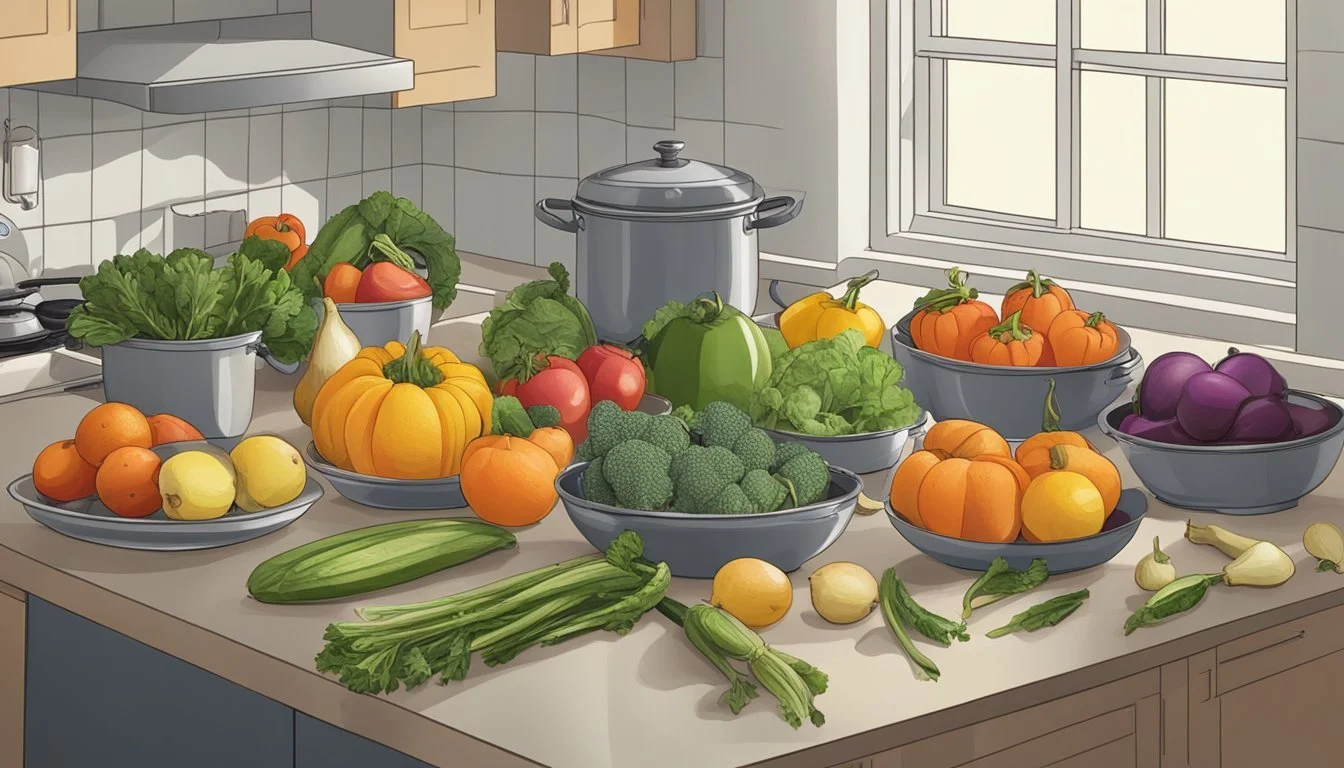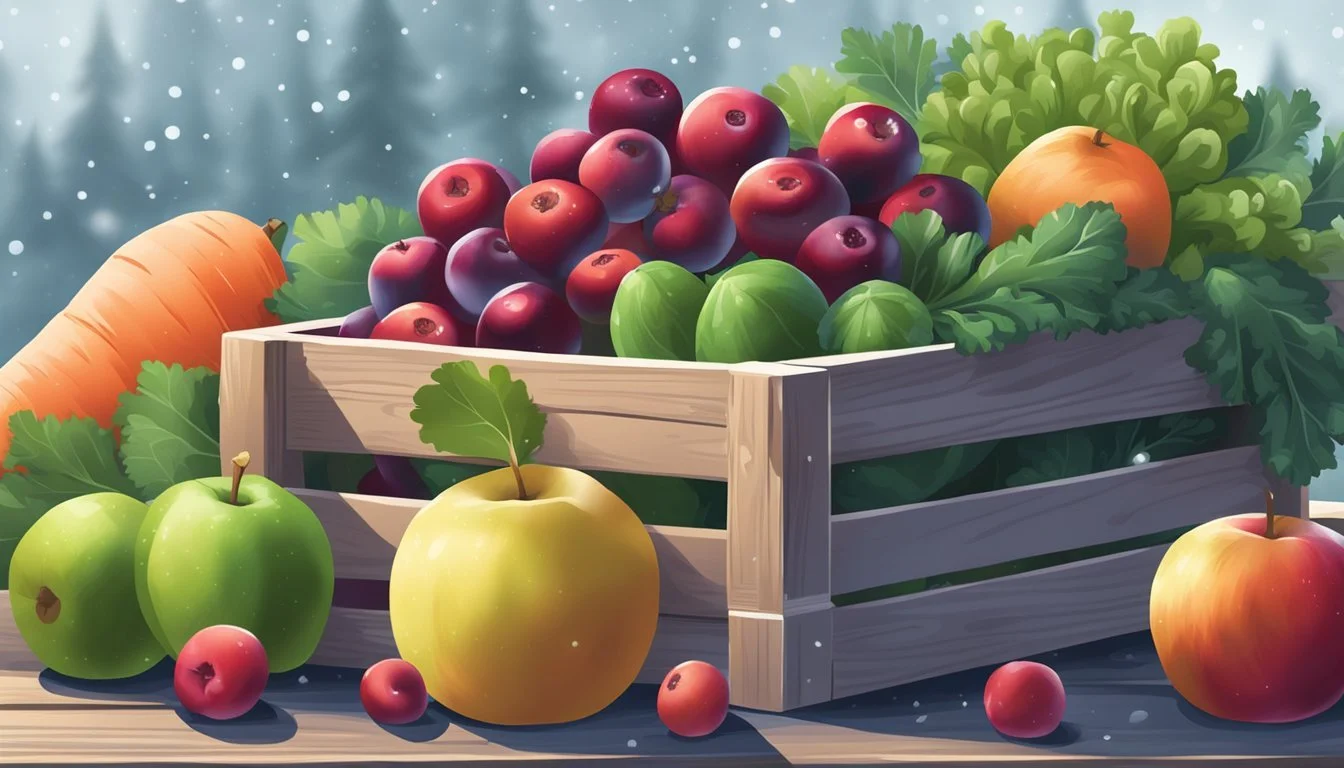Minnesota Seasonal Fruit & Vegetables in December
Your Fresh Guide
This Article is Part of our Minnesota Seasonal Fruit & Veg Calendar
In Minnesota, the month of December ushers in a unique palette of seasonal produce, despite the cold climate and shorter days. During this period, local farms and markets adjust to the winter's offerings, which encompass a range of hardy vegetables and the last batches of fruits that can withstand the frost. While the assortment is more limited compared to the summer months, Minnesotans still enjoy a variety of fresh, locally-grown items.
Seasonal fruits available in December include storages of apples that were harvested in the fall and are still in excellent condition, along with cranberries, a native North American fruit commonly associated with the holiday season. The state's vegetable produce shifts towards cold-weather crops like root vegetables, including carrots, parsnips, and beets (how long do beets last?), which are notable for their ability to keep well into the winter months.
The selection of leafy greens also reflects the seasonal change, with varieties such as kale and spinach thriving in cooler temperatures. These crops, alongside greenhouse-grown herbs, provide Minnesotans with fresh greens even as the snow blankets the fields. Local producers often rely on cold storage and indoor growing techniques to extend the availability of their harvest, ensuring Minnesotans have access to seasonal produce throughout the chill of December.
Overview of Minnesota's Seasonal Produce
Minnesota's climate plays a crucial role in the types of fruits and vegetables available during the winter season. In December, residents often look to farmers markets and produce guides to navigate the limited growing season.
Climate and Seasonality
Minnesota experiences a continental climate, characterized by cold winters and warm summers. The growing season is rather short, spanning from late spring to early fall. During winter, most outdoor crop production comes to a halt, and the availability of fresh, local produce decreases significantly. Farmers markets and co-ops may shift their focus to storage crops and greenhouse-grown produce to provide fresh options.
The Impact of December's Weather
December's weather in Minnesota is typically marked by freezing temperatures and snow. The harsh conditions largely restrict growth to cold-hardy or greenhouse-grown produce. Root vegetables, stored from the fall harvest, dominate the offerings at farmers markets. These include:
Beets
Carrots
Potatoes
Meanwhile, greenhouse operations might yield limited quantities of vegetables like lettuce and herbs. Preserve and storage techniques also ensure that some fruits, such as apples, which were picked prior to winter, remain available. This seasonal guide reflects the resilience of the state's agriculture and the adaptability of its producers during the challenging winter months.
Seasonal Vegetables in December
December in Minnesota brings a bounty of hardy vegetables that thrive in the colder climate. These nutrient-rich selections can add freshness and fiber to winter meals.
Root Vegetables and Tubers
Potatoes: A staple in many kitchens, they offer versatility and a significant amount of dietary fiber. Varieties such as Russet and Yukon Gold are readily available.
Carrots: Known for their beta-carotene content, these are perfect for both raw and cooked dishes.
Turnips: These slightly spicy root vegetables can be mashed or roasted.
Rutabagas: Sweeter than turnips, ideal for stews and casseroles (What wine goes well with casseroles?).
Celery Root (Celeriac): With a distinctive taste, it is excellent mashed or used in flavorful soups.
Cruciferous Vegetables
Cauliflower: Can be enjoyed raw, steamed, or roasted, offering a substantial amount of Vitamin C.
Kale: This leafy green is high in vitamins and can be used in salads, smoothies, or as a cooked side dish.
Cabbage: Versatile and fibrous, suitable for slaws, sautéing, or fermenting into sauerkraut.
Brussels Sprouts (how long do brussels sprouts last?): Rich in antioxidants and best enjoyed roasted or steamed.
Broccoli: High in fiber and vitamins, it can be consumed fresh or cooked.
Leafy Greens and Herbs
Spinach: A versatile green, packed with nutrients for salads or cooked preparations.
Chard: Offers a colorful and nutrient-dense option for a variety of dishes.
Lettuce: Different varieties like Romaine provide a fresh, crisp base for winter salads.
Herbs: Hardy herbs such as rosemary and thyme are available and can enhance the flavor of any dish.
These vegetables can sustain Minnesotans through the winter while providing essential nutrients and maintaining a connection to seasonal eating.
Seasonal Fruits Available in December
Minnesota offers a variety of fruits in December, with a focus on citrus and hardy types that withstand the colder temperatures. These fruits often provide a balance of sweet flavors and a boost of antioxidants during the winter months.
Citrus Fruits
In December, Minnesotans can enjoy a burst of freshness with citrus fruits. While local options are limited due to the climate:
Clementines: They are a popular treat during the winter, known for their sweet flavor and ease of peeling.
Oranges: A classic choice, oranges are valued for their sweet taste and high vitamin C content, making them a staple for the cold season.
Hardy Winter Fruits
Several fruits that last well into the winter are also available, which includes but is not limited to:
Cranberries: Harvested in the fall, they remain available throughout December. Often found in festive dishes, these tart berries are also known for their antioxidant properties.
Pears: Providing a sweet and slightly buttery flavor, pears are another winter favorite that pairs well with both sweet and savory dishes.
Apples: With varieties that store well, Minnesota apples can still be crisp and delicious in December.
Persimmons: These fruits come into season in the late fall and can extend into the winter months.
Pomegranates: Known for their jewel-like seeds and sweet yet tangy taste, pomegranates can also be found during this time.
Preparing and Cooking Seasonal Produce
In December, Minnesota's selection of seasonal produce inspires a variety of cooking methods and recipes designed to bring out rich, comforting flavors and provide nutritional benefits during the colder months.
Cooking Techniques for Cold Weather
When it comes to seasonal produce in cold weather, it is essential to employ cooking techniques that enhance the natural flavors and maintain nutritional value. Roasting vegetables such as root vegetables in a preheated oven with a drizzle of olive oil and a sprinkle of salt can bring out their earthy sweetness and creates a perfect side dish or component for salads and casseroles. Boiling can be utilized for producing a base for soups or softening ingredients for mashes and purées that can be seasoned to taste and serve as a comforting food. Baked dishes such as squash filled with a mixture of wild rice (how long does wild rice last?) and mushrooms make a nutritious and warming meal. Minnesota's cold-tolerant greens like kale can be lightly cooked or used raw in salads for a fresh element amidst rich, heated dishes.
Recipes and Pairings
December in Minnesota offers a trove of produce perfect for recipes and pairings that cater to festive occasions and everyday meals.
Casseroles: Incorporate roasted root vegetables such as carrots and turnips into casseroles for a hearty meal.
Soups: Blend boiled pumpkin or squash into a creamy soup base, adding spices such as nutmeg (how long does nutmeg last?) for a seasonally appropriate flavor.
Salads: Complement the boldness of raw greens like kale with the sweetness of roasted beets, topped with a tangy vinaigrette and nuts.
Sauce: Thicken a reduction of pan juices with pureed parsnips or potatoes to create a flavorful sauce for meats or legumes.
Grilled: While less common in the winter, Brussels sprouts can be halved and grilled for a charred, smoky flavor, making an excellent side dish or addition to winter salads.
By utilizing these techniques and ideas, one can create nourishing, flavorful dishes that pay homage to the season's offerings.
Health Benefits of Eating Seasonally
Eating seasonally provides numerous benefits for one's health. Minnesota's winter may not be abundant in fresh produce, but seasonal produce available in December offers a valuable nutritional profile that supports overall well-being.
Nutrient Density: Seasonal fruits and vegetables harvested at their peak are packed with nutrients. They tend to have a higher vitamin and mineral content than those harvested before they ripen fully and transported long distances. For example, eating seasonal kale can replenish one's daily requirements for several essential vitamins.
Freshness and Flavor: Freshness is key when it comes to the taste and nutritional composition of produce. Seasonal items are often fresher, having been harvested at the right time, which means they maintain more of their flavor and nutritional value.
Key Nutrient Benefits Fiber Aids digestion and can help regulate blood sugar levels. Antioxidants Protect the body from oxidative stress and reduce inflammation. Iron Essential for oxygen transport in the bloodstream.
Local Produce: Locally-grown, seasonal produce is often fresher than imported fruits and vegetables, as it doesn’t require long transit times. This freshness can translate to more antioxidants and fiber, which are essential for maintaining good health.
Environmental Benefits: While not a direct health benefit, choosing seasonal, local produce supports sustainable practices and usually means a lower carbon footprint due to reduced transportation. This environmentally conscious choice indirectly benefits one's health by promoting a healthier planet.
Incorporating seasonal vegetables like leeks and herbs in December adds variety to the diet, supplying a range of nutrients, antioxidants, and fiber. People can complement their meals with stored or fermented produce like cabbage, which is rich in vitamins and minerals, to enhance their nutrient intake during the colder months.
Where to Find Minnesota Seasonal Produce
In December, Minnesota's selection of local, seasonal produce is more limited due to the cold Midwest climate. However, consumers can still find a variety of fresh goods sourced from within the state.
Local Farmers Markets
Farmers markets continue to be a primary source for fresh seasonal produce in Minnesota. Amidst the chill, some markets move indoors offering limited local products. Shoppers often find root vegetables like potatoes and turnips, as well as winter squashes and a variety of greenhouse-grown herbs. A well-known market is the Minneapolis Farmers Market, held on weekends throughout the year, which transforms into an indoor haven for fresh goods during the colder months.
Notable Indoor Markets:
Minneapolis Farmers Market
St. Paul Farmers Market Indoor Holiday Market
Grocery Stores and Co-ops
Minnesota's grocery stores and co-ops often showcase a selection of local produce that adjusts with the seasons. These stores prioritize stocking state-sourced products, evident even in December. Shoppers should look for signage indicating Minnesota-grown produce to support local farms. Co-ops, in particular, are dedicated to local suppliers, offering a platform for regional Midwest farmers to distribute their harvest.
Local Produce Indicators:
"Minnesota Grown" labels
"Local Farm" signage
Conclusion
In December, Minnesota's seasonal offerings are lean towards storage crops and sturdy vegetables that can withstand frost. Cruciferous veggies, such as broccoli and brussels sprouts, wrap up their season in early winter, while storage heroes like beets offer sustainability throughout the colder months.
The local farmers of Minnesota have harvested their fruits such as cranberries in the fall, ensuring they are available fresh for December. Root vegetables are at their peak, adding heartiness to winter dishes. Beets, known for their anti-inflammatory properties, are a staple, and their ease of preparation—roasting, boiling, or steaming—makes them a versatile choice.
Produce Type Attributes Cranberries High in antioxidants Beets Anti-inflammatory, versatile Broccoli Rich in vitamins, ends season Brussels Sprouts High in fiber, ending season
Consumers should note that raspberries are also more affordable during this month, though not typically in season in Minnesota.
Minnesotans have the opportunity to support local agriculture by embracing these December offerings. It underscores the importance of adapting culinary practices to the rhythms of the seasons and the local environment. By doing so, they encourage sustainable agriculture and get to enjoy produce at its nutritional and flavorful best.









